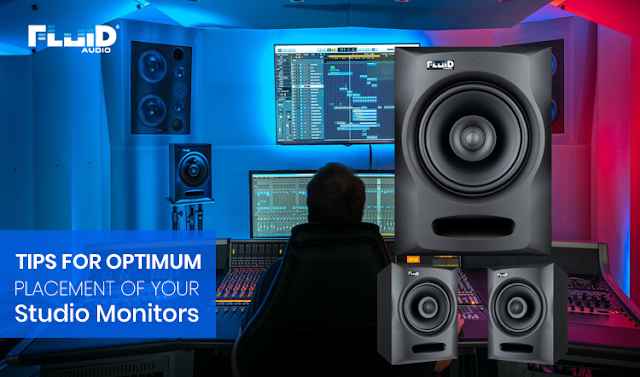Tips For Optimum Placement Of Your Studio Monitors
The perfect tool for mixing and mastering your songs, studio reference monitors are essential to any functional recording studio. Every decision that we make in the mixing process is based on the sound that we hear coming out of audio monitors. That being said, a lot of artists and producers just starting out don’t realize how important it is to set up studio monitors in a way to get the most out of them. Sometimes even seasoned vets don’t realize how much better they could make their beats/songs sounding by setting them up correctly. How far must they be placed from your ears? Should they point at you, and at what angle? What kind of desktop stands do you need to buy?
Here are a few simple rules to follow to get the best out of your freshly acquired studio monitors!
1. Place them away from walls – Placing your monitors too close to a wall or a corner of a room can cause bass “loading” which boosts the low frequency of your monitors while creating a null in the upper-bass frequencies. This can have a negative effect on your final mix because an accurate bass response is extremely crucial for mixing music. Since all rooms are different, experimentation with your monitor placement is not uncommon until you achieve the perfect sound that is clear and full response. If you cannot move your monitors away from walls (due to space restrictions) you’ll need some acoustic damping and bass traps to help with this issue.
2. Symmetry is crucial – This is a ground rule to be followed every time: Your monitors must be positioned to form an equilateral triangle in relation to your listening position. If you still remember your math lessons, the equilateral triangles are equiangular, where all the three angles are equal at 60 °. This is essential to let your monitors “breathe” and reproduce all frequencies without interference. And your left and right speakers should not be too close to the left or right wall of your room to avoid reflections and bass loading.
3. Keep your monitors at the right distance from you – Though there are different types of studio monitors, the type we are discussing here is the near–field variety, so it’s quite obvious that they must be placed in fairly close proximity to the listener. Near-field monitors are designed to be used at close ranges and are pretty easy to work within small spaces. They are made to be used in under two feet of space from the listener. The closer they are, the less room acoustics you will affect the sound that reaches your ears.
4. Horizontally or vertical positioning – If you are looking for the best sound reproduction, it is best to position your near-field monitors vertically (with the tweeter on the top). This ensures that the distance between the listening position is the same between the treble and bass speaker. Even though it may not be aesthetically pleasing, you should always position your speakers vertically. In the case that they are too high, you can slightly tilt them down so that the tweeters are directed towards your ears. However, if you still decide to place them in a horizontal position, make sure to place the tweeters outside. Of course if you’re speakers happen to be a coaxial design like the FX Series from Fluid Audio, it doesn’t matter much as their tweeters sit in the middle of the woofer, and create a symmetrical radiation pattern.
5. The optimum height – Height is important as it can make or break your ability to accurately hear your music. In most home studios, keeping your monitors at your ear’s height is the safest bet. This is because the high frequencies coming from your tweeters are a lot more directional or “beamy” than the woofer, or low frequencies. So, if your tweeters are not close to the same axis as your ears, they will sound rolled off (as if it had a low pass filter on them). Keeping the tweeters at ear level helps in focusing the sound on you and keeps you safe from any extra noise.
6. What to position your Monitors On – The importance of placing your monitors on monitor stands can’t be stressed enough. Monitor stands provide a wide range of studio monitoring benefits and cause a dramatic improvement in your studio monitor performance. Desktop stands help by greatly reducing speaker cabinet vibrations transmitting into other masses and structures such as desks, workstations, and mixing consoles. Monitors placed on something like a desk can sound a bit fuzzy and colored in the midrange and “thin” in the bass. This is caused by vibrations from the cabinets rumbling into the mass of the desk that the monitors are sitting on making your monitoring experiences less than ideal. Most stands use rubber to isolate the speaker from what it’s sitting on. This is called “decoupling” and makes your speakers much cleaner sounding and less distorted in the vocal region. Optimizing the sound of your speakers will give you the most accurate representation of what’s actually going on in your mixes, enabling you to make better mixing decisions. Following these tips will guarantee that your mixes end up sounding better not only in your studio, but on other sets of speakers as well.



Comments
Post a Comment